<Back to Index>
- Architect François II d'Orbay, 1634
- Secrétaire de l'Académie Royale d'Architecture André Félibien, 1619
PAGE SPONSOR
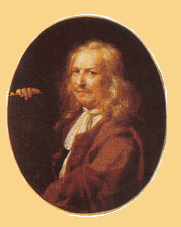
Francis II d'Orbay, born in 1634 in Paris where he died on 4 September 1697, was a French architect.
Son of Francis I d'Orbay, architect and writer, he was one of the favorite pupils of Le Vau, and became his son. D'Orbay began conducting with Pierre Lambert, the work in the Church of the College des Quatre Nations and several major works in the Louvre and the Tuileries, under the sound direction of his master, with 1,200 pounds of liens, from 1662 to 1665.
Meanwhile, he built the church of Premonstratensian nuns (engraved by Marot). On 3 May 1664, he received 600 pounds, half of his wages for 1663, for design and conduct of royal buildings. On 10 August 1666, he still received 400 pounds for work done as architect of the royal buildings. In 1671, he received 1,200 pounds for designs, plans and building royal buildings. At the same time, he designed the gate of Trinity Church, St. Denis Street (also engraved by Marot) (destroyed). Finally, on December 31 of that year he was admitted to the Royal Academy of Architecture, at its foundation. On the death of his stepfather, he became architect of King Louis XIV .
From 1675 to 1679, d'Orbay directed the work at Versailles, designed by Le Vau. From 1686 to 1688, he built the Capuchin Convent, Rue Neuve des Petits Champs, and at the latter date, the King's Theatre of Actors, Rue des Fosses Saint - Germain. His works in Paris included those at Saint - Germain l'Auxerrois with Le Brun, the Premonstratensian church, the Red Cross, the gateway to that of the Trinity, Saint - Denis. At Lyon he raised in 1682, the portal of the former Carmelite church and chapel of Villeroy. It was he who also designed the plans of the Gate, or triumphal arch of Montpellier, built by Aviler in 1685. D'Orbay was rewarded by 1000 pounds for royal buildings from 1672 to 1680 and 2000 pounds in 1678.
He was connected with Boileau who used his testimony to interfere with Perrault and get credit for having supplied the drawings of the colonnade of the Louvre. When he died, his funeral service took place at Saint - Germain l'Auxerrois.
According to architect Albert
Laprade, François
d'Orbay was a misunderstood genius who was crushed by
courtiers such as Louis
Le Vau and Jules
Hardouin - Mansart but who
actually turned out to be a better architectural
designer.
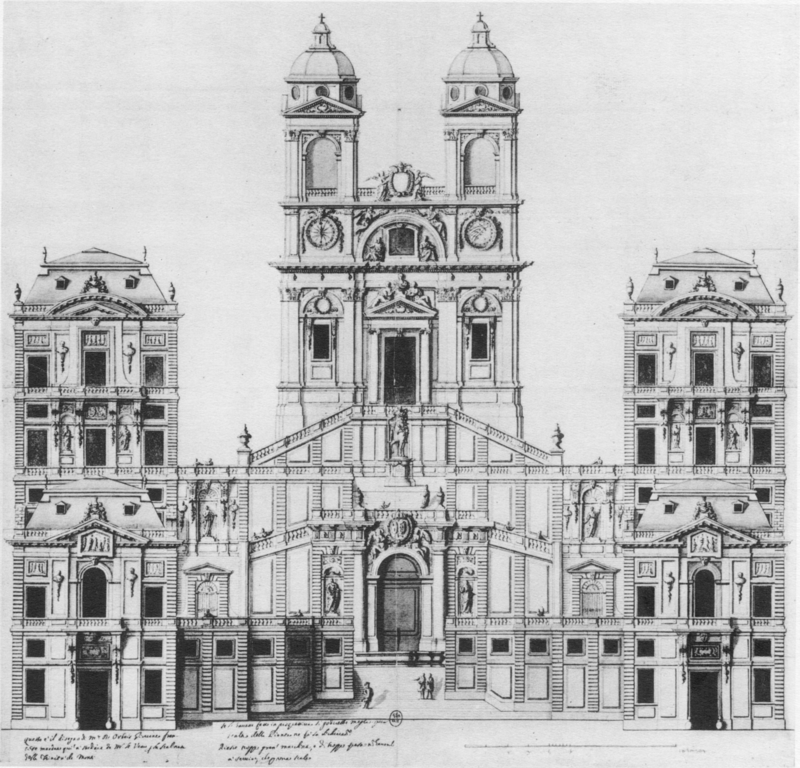
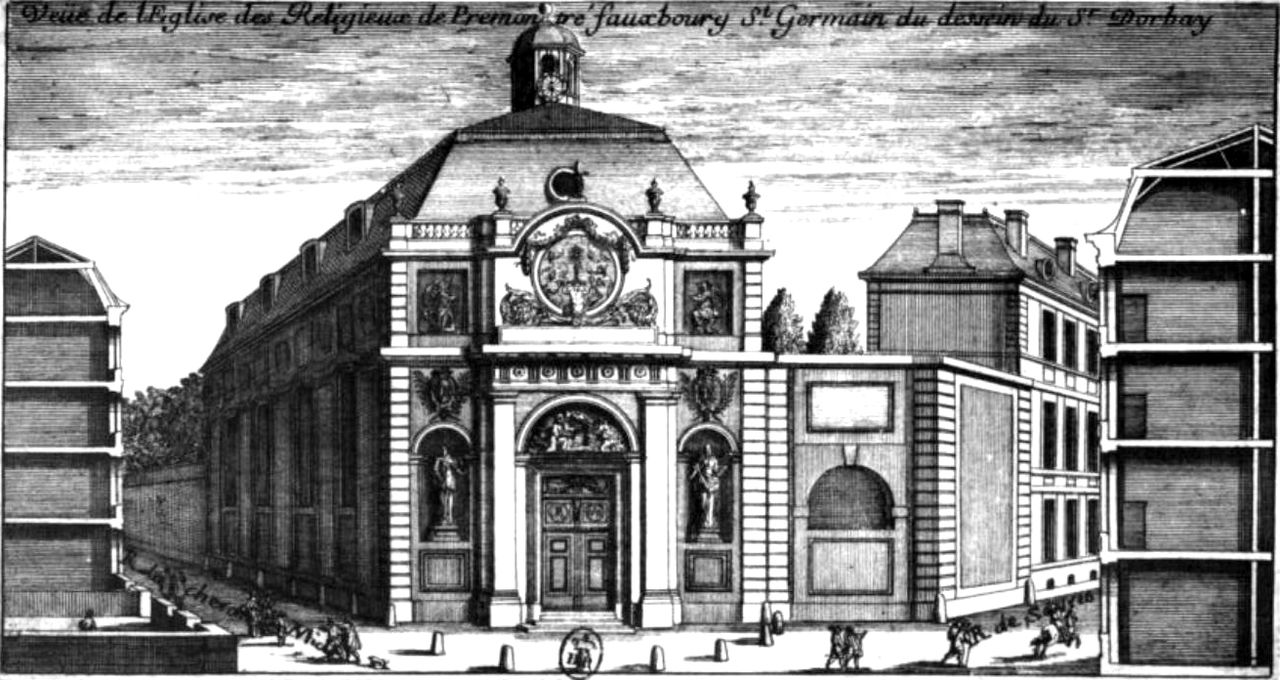
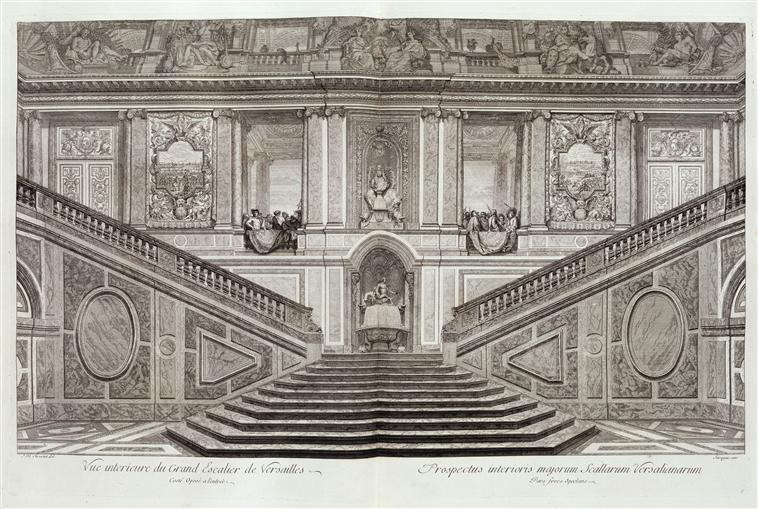
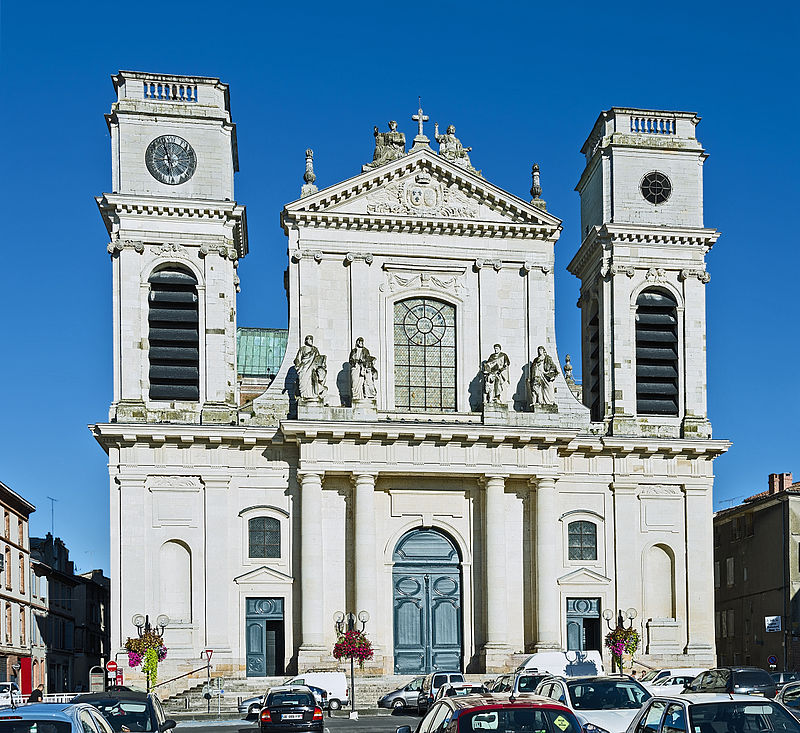
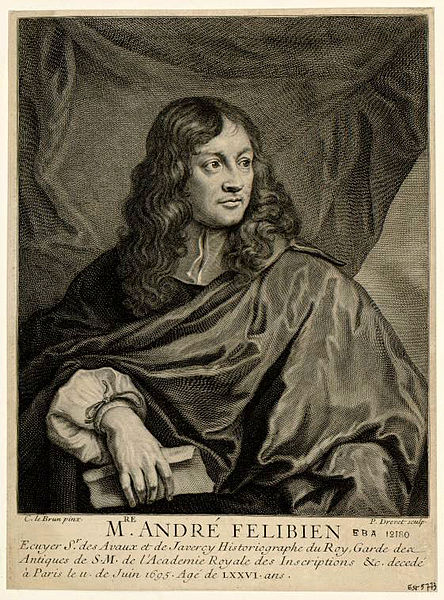
André Félibien (May 1619 - 11 June 1695), sieur des Avaux et de Javercy, was a French chronicler of the arts and official court historian to Louis XIV of France.
Félibien was born at Chartres. At the age of fourteen he went to Paris to continue his studies; and in May 1647 he was sent to Rome in the capacity of secretary in the embassy of the marquis de Fontenay - Mareuil. His residence at Rome he turned to good account by diligent study of its ancient monuments, by examination of the literary treasures of its libraries, and by cultivating the acquaintance of men eminent in literature and in art, with whom he was brought into contact through his translation of Francesco Cardinal Barberini's Life of Pius V. Among his friends was Nicolas Poussin, whose counsels were of great value to him, and under whose guidance he even attempted to paint and whose biography Félibien wrote, which remains "the most persuasive guide to the work, as to the life" of Poussin, as the biography's modern editor Claire Pace observed.
On his return to France he immediately began working up his notes for the eight volumes of Entretiens he eventually published. He married and was ultimately induced, in the hope of employment and honors, to settle in Paris. Both Fouquet and Colbert in their turn recognized his abilities; he was one of the first members (1663) of the Academy of Inscriptions. Three years later Colbert procured him the appointment of court historian to the king, in which one of his commissions was the minute descriptions of court fêtes, an essential element of the king's cultural propaganda. In 1671 he was named secretary to the newly founded Académie d'architecture, where he gave lectures, and in 1673 he was appointed keeper of the cabinet of antiquities in the Palais Brion. His Description sommaire (1674) was the official guide to Versailles. To these offices was afterwards added by Louvois that of deputy controller general of roads and bridges.
Félibien found time in the midst of his official duties for study and research, and produced many literary works. Among these the best and the most generally known is the Entretiens sur les vies et sur les ouvrages des plus excellents peintres anciens et modernes, which set the nascent discipline of art criticism on sound logical footings, which Félibien set forth most coherently in his Principes de l'architecture, de la sculpture, de la peinture, &c. (1676 - 1690).
Félibien wrote also L'Origine de la peinture (1660), and descriptions of Versailles, of La Trappe Abbey, and of the pictures and statues of the royal residences. He published a straightforward work of information, Des principes de l'architecture, de la sculpture, de la peinture... avec un dictionnaire des terms anonymously in Paris, 1676; in it H.W. van Helsdingen has detected that he made use of an unpublished work of critical Observations by Charles Alphonse du Fresnoy. Among other literary works, he edited the published Conferences of the Académie royale de peinture et de sculpture and translated the Castle of the Soul from the Spanish of St. Theresa. His personal character commanded the highest esteem, agreeing with the motto which he adopted - Bene facere et vera dicere, "Do well, and tell the truth". Félibien's codification of the aesthetic values of the classic arts in the hierarchy of genres is perhaps his most enduring legacy. André Félibien and Roger de Piles, author of Dialogue sur les coloris (Paris, 1673) "were and are the best - known writers on fine arts in seventeenth century France". He died in Paris in 1695.
His son, Jean François Félibien (c. 1658 - 1733), was also an architect who left a number of works on his subject; and a younger son, Michel Félibien (c. 1666 - 1719), was a Benedictine monk of Saint - Germain - des - Prés whose fame rests on his history of the Abbey of Saint - Denis and also his L'Histoire de l'école de Paris in 5 vols., a work indispensable to the student of Paris.
Félibien's diaries are among the bound volumes of his papers conserved in the public library of his birthplace, Chartres. The only recent work wholly devoted to Félibien is Stefan Germer, Kunst, Macht, Diskurs. Die intellektuelle Karriere des André Félibien im Frankreich von Louis XIV (Munich), 1997; it supplants the brief report in A. Fontaine, Les doctrines d'art en France (Paris) 1909:41ff.